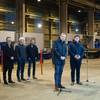Insights: Frank Foti - President and CEO, Vigor Industrial LLC
For nearly two decades, Frank Foti has led Vigor’s transformation from a single, struggling shipyard to a thriving, increasingly diversified industrial company with 2,500 employees, 12 locations and approximately $700 million in annual revenue. According to Vigor, Foti often describes his motivation in three words: “Industrial Jobs Matter.” Committed to improving long-term, family-wage job opportunities workers and their families and communities, Foti and his management team have, over time, has worked to strategically expand and diversify the company, investing in training facilities and infrastructure along the way. Also according to Vigor, the firm has endeavored to partner with organized labor to develop the firm into a company driven by four core values: truth, responsibility, evolution and love. Under Foti’s leadership, Vigor’s annual revenues have grown from $80 million in the late 1990s to about $700 million today. At the same time the company has diversified to offer shipbuilding, blasting and coating, machining and advanced fabrication services at locations including Ketchikan and Seward, Alaska, Portland and Clackamas, Ore., and Port Angeles, Everett, Tacoma, Vancouver and Seattle, Wash. This month, the charismatic and enthusiastic Foti weighs in on the domestic shipbuilding scene during a time of challenges for the entire maritime cluster. Listen in as Foti tells it as only he can do:
Give the readers your broad stroke view of the shipbuilding markets today.
In two words: absolutely challenging. A large portion of U.S. shipbuilding is driven by oil exploration. Few new vessel orders are being placed, vessels options have largely been canceled, and we have a glut of ships tied up waiting for work. That said; there are still some bright spots in certain niche markets. Ferry construction is strong. Vigor itself is currently building six ferries; two Alaska Class ferries, two 144-car ferries, and two all-aluminum 400-passenger only ferries. Patrol boats are another bright spot and Kvichak, our newest member of the Vigor family, is doing well in that sector. The fishing vessel market is waking up and while we are seeing signs of slowing in the tug and barge market there is still business to be had.
Where are we headed tomorrow?
Before the price of oil rises and exploration is resumed, it’s likely the industry will see more consolidation.
How much has the energy crunch hurt backlogs?
There is no doubt the energy crunch has significantly eroded backlogs for shipbuilding in the U.S. and abroad. On a recent trip to Oman, Keith Whittemore, our EVP of business development, observed bulkers being converted to tankers for oil storage. This is happening everywhere.
Can you give us a sense of your backlog? How deep is it and how far out does it extend?
Vigor is a diversified company with the critical mass needed to provide stability for our workforce. Forty-five percent of Vigor’s business is in ship repair, 40 percent in shipbuilding, and 15 percent in non-marine fabrication. Our non-marine business is growing, our ship repair business is expected to grow slightly from last year, and our shipbuilding backlog ranges from 1.5 to 3.5 years depending on the location. If and when the market for shipbuilding rebounds, we will be there.
We’re arguably at the backend of one of the longest upswings in the U.S. newbuild markets that domestic yards have seen in many decades. But, this has always been a cyclical industry. That said; when do you see the pendulum swinging back up again?
I wish I had that crystal ball but I suspect we are a ways away. Likely a few events will need to take place before we see a significant swing of the pendulum. The price of oil will have to rise and oil reserves decline. Vessels currently tied up waiting for work will need to be back in service and new exploration will have to resume.
Recruitment and retention in shipyards is a big issue today. Tell us a little about your human resources philosophy. Is it yielding fruit and where do you see the biggest demand for personnel from your perspective?
At Vigor, it’s all about understanding what our business needs are today and anticipating what it will need as we evolve. There is no question that finding skilled workers is a challenge so we’ve invested heavily in workforce development. In both Seattle and Portland, Vigor has partnered with Community Colleges to open training centers to create a pipeline of workers with the right welding skills for shipyard work. We provide space and tools and subsidize the salaries of the instructors, while the colleges administer the courses – including admissions – and issue certificates. Vigor provided input to help adapt the college’s existing welding curriculum for shipyard work. In 2014 we began working with the Alaska Workforce Investment Board (AWIB) and the University of Alaska Southeast Ketchikan Campus (UAS-Ketchikan) to create an industry-led training program tied into our Ketchikan yard. All three of these programs provide the specific training necessary to help students land family wage jobs at our shipyards or other area employers. In addition we provide internships and support high school programs. Within Vigor, we provide on-the-job training, and we use our more experienced craftsmen to mentor and train. We are constantly developing internal talent and have training programs in place that cover employees from the shop floor to executive leadership.
What percentage of your work involves newbuild and what percentage is repair?
A few years ago, 80 percent of our business was ship repair. Now, thanks to our growth and diversification efforts, 45 percent of Vigor’s business is in ship repair, 40 percent in shipbuilding, and 15 percent in non-marine fabrication.
Describe the Vigor portfolio of shipyards. How many do you have now and where are they located?
We now have a total of 12 facilities. Our Swan Island facility is a full-service yard in Portland, Ore. This is where our new Vigorous drydock is located and is also our corporate headquarters. Our Clackamas facility (also Oregon) is primarily devoted to both marine complex fabrication and non-marine work. We perform a large amount of our non-marine fabrication in Vancouver, Wash. We have four facilities in the Seattle area, our Harbor Island yard which is a full-service yard; our Ballard location home to Kvichak’s specialized aluminum workboat production facility; a state-of-the art metal processing facility in South Park; and an additional aluminum production facility in Kent for high performance vessels. We have four additional marine repair facilities in Washington located in Tacoma, Everett and Port Angeles. Alaska facilities include the full-service yard in Ketchikan and the repair yard in Seward.
Your recent and robust expansion and acquisition program arguably has Vigor not only well diversified in terms of portfolio and capabilities, but also in terms of geographic reach. How is all that – the integration – and leveraging of different strengths coming together?
It’s hard, and it’s coming together in a wonderful way. In the work we do, in virtually all locations, every project is unique. Sure, we’ve had a few production runs of components or vessels, but production fabrication it is not. With nearly half our business being in ship repair, we figure things out as “ship happens.” So, we place a premium on thinkers and doers who can approach every job, every day, with a “child mind plus.” Child mind in the sense of looking at every situation fresh and on its on merits. “Plus” for drawing on the database of prior experience and seeing where that knowledge can be used to make things better. On our good days, we take the best of what our experience brings without bringing in the rigidity that comes from thinking that you already know. The cross-pollination of ideas, project planning and advanced manufacturing skills is exciting. We are much better builders/repairers today and expect to be even better in the future.
Give us an example of how synergy from yard transfers into better production and quality in another, within your portfolio of ship and boatbuilding facilities.
Probably one of the most significant synergies has been the collaboration of former Kvichak and the former Oregon Iron Works staff into the leadership ranks of Vigor’s existing fabrication operations. Vigor, Kvichak, and Vigor Works staff have come together as a team to share specialized resources and knowledge for the fabrication of high performance military vessels, barges, ferries, and virtually everything we build.
Your new dry dock has arrived and now gives ship owners – foreign and domestic alike – more choices on the U.S. West Coast. How much traffic have you seen and is the dry dock being utilized to its maximum extent possible?
Since going into service in our Portland shipyard in November of 2014, Vigorous has been consistently booked, supporting hundreds of jobs and attracting work which could not have been done in the region without a drydock of its size. Repair work has included both military and commercial vessels, including two cruise ships. Following the acquisition of the dock we call Vigorous, we also invested significant funds to upgrade and transfer one of the Portland drydocks to our Seattle facility. The work performed will extend the life of the upgraded drydock for another 20 years.
What is the capacity of that dry dock?
Vigorous is 960 feet long by 186 feet wide with a lift capacity of 80,000 long tons. The added width of the dock has provided a lot of efficiencies for hull and fin stabilizer maintenance and our cold ironing capabilities have been very attractive to customers.
The domestic fishing vessel market is finally – after decades of malaise – perking up a bit. Are you targeting that market and do you have any of that business?
Yes, we are in active development of products and projects for the North Pacific fleet. These run the gamut from smaller aluminum fish boats to large factory processors. Our teams know how to build for the North Pacific and understand the needs fisheries in our region. In fact, Kvichak got its start back in 1981 building fish boats and has continued to do so for 35 years.
U.S. yards increasingly are finding ways to build competitively (against foreign yards) in certain niche sectors and in some cases, are exporting hulls to direct sales to governments and the private sector. This typically occurs in the OSV size and smaller. Does Vigor build for foreign clients and/or export new build hulls?
Yes. Vigor is exporting new builds in the military and some niche commercial markets. We recently delivered two pilot boats to the Port of Duqm in Oman, and over the years we have successfully delivered boats to Chile, The Netherlands, Russia, Canada, Nigeria, and Brazil. We currently have other military and commercial orders under active negotiation.
(As published in the April 2016 edition of
Marine News)














